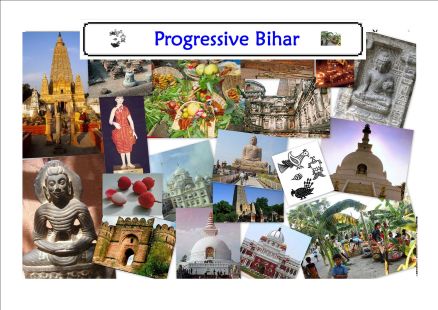It was not known to me but half of India's dolphins are found in the water of Ganges (Ganga) river in Bihar. However, this population of dolphins will start facing extinction if their killing is not stopped immediately.
There are two reasons for extinction.
1. Contaminated wastes released by industries into Ganga
2. Fishermen killing the dolphin's to use their oil for making fishing bates.
Dolphin's have been declared national indian aquatic animal recently. But even besides that it would be lovely to have dolphins around and can become a source of dolphin tourism in Bihar.
Alternatives have to be found for the fishermen folk so that they can switch over to other materials for fishing bates. Secondly, the pollution control mechanism has to kick in to quickly stop industries from releasing contaminated wastes into Ganga across the various states Ganga flows in. While efforts have been going on, on this front from quite sometime, the efforts have to be increased and the industrialists have to realize that it is important to save the Ganga from any further contamination. They might incurr a small cost to find out alternate ways of waste disposal but the benefit of this act on humanity will be tremendous.
Since a lot of rivers feed into Ganga, dolphin's are found in other rivers , like Gandak , etc too. Hence it is equally important to protect the dolphin population there.
I appreciate PU zoology department Professor R K Sinha, who has single-handedly led a struggle to save the Ganga dolphins. Let us support him and his efforts in anyway possible which includes even just spreading the words on saving the dolphin population.
Tourism: Dolphin keep changing habitats with the changing seasons and right now good numbers are found in the Ganga in Patna and Vikramshila Gangetic Dolphin Sanctuary in Bhagalpur. Last month, Prof. Sinha sailed 200 kms in the Gandak in a boat and spotted a dolphin every km. So the tourism enthusiats planning on a holiday might consider going on a dolphin tourism in Bihar.
An interesting article to save the dolphin's can be found here "Enforce ban on killing of dolphins, DMs told". More details on Prof. Sinha can be found at http://dolphinsinha.com

Almost ten years ago I developed an alternative to the Ganges River dolphin oil used by the local fishermen as fish bait. This oil is extracted from fish scraps thrown along the road side near any fish market. From the peritoneal fat attached to the viscera mainly of Rohu, Katla and Mrigal fishes, the oil can easily be extracted by heating the same in any utensil. This can be used as an alternative to the dolphin oil to support oil fishery.
ReplyDeleteWe conducted field trials for 500 hrs in 121 days spread over three years with the help of local fishermen, published the findings in a reputed Journal"Biological Conservation" published from Elsevier from London in 2002. To popularize the oil among fishermen we undertook extension program at Patna, Bhagalpur and Kahalgaon in Bihar and also in Brahmaputra River in Assam from where fishermen were trained by us. They are using this alternative oil and earning good return besides saving the dolphin. Also this oil adds value to the scrap which is otherwise a big nuissance along the road side.
The Ganges dolphin got the status of National Aquatic Animal of India by the Prime Minister on 5th October during the First Meeting of the National Ganga River Basin Authority at the Residence of the Prime Minister. In the meeting, as one of the co-opted Expert Members of the Authority, I explained the ecological and economic importance of the dolphin and requested the Prime Minister to declare the dolphin as a National Aquatic Animal. During an International Conference on Ganga organized by me at Patna University in Nov 2006 I had requested the Chief Minister of Bihar Sri Nitish Kumar to get this species status of National Aquatic Animal and he had written two letters to the Government of India with the same request. On my request and the two letters of the CM, Prime Minister declared the Ganges Dolphin as National Aquatic Animal then and there. Indeed it was very exciting for me and Sri Nitish Kumar who told me "tab apka sab kam to ho gaya" just after the meeting was over.
Promoting eco-tourism to watch dolphin in its natural habitats will provide one of the alternative livelihoods to the fishermen and help save the dolphin also. By saving a dolphin, fishermen can earn the money daily, equal to what they can earn only one day by killing a dolphin. Moreover, the species is our Aquatic heritage as it is endemic to the rivers of the Ganga-Brahmaputra system. It is our prime duty to save the species from extinction.
I greatly appreciate your efforts Prof R K Sinha in saving "Sons". It is a unique aquatic mammal found in Ganga and indeed our eco system will be far poorer in its absence.
ReplyDeleteI propose we have a brainstorming session on how to make this animal better known. Even well educated people from Patna itself are quite unaware of this fantastic creature which "sees" through triangulation as it is almost blind.
Are there movies on this creature? Can we have movies on this animal? Being in Mumbai, I am in touch with some movie makers who can take this topic up. I for one have not seen much in National Geographic and the like which can be a big boost in the conservation effort.
Specifically regarding the oil substitute, I am totally impressed by your efforts. Perhaps there is a big need to involve local NGOs. which I am sure you must be doing.
Thanks